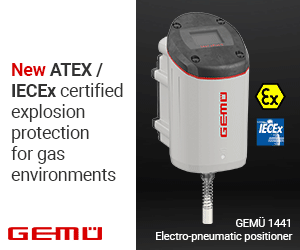Asset Identification in Difficult Environments
Property managers in every sector face challenges with identification and tracking of assets. The property manager function appears in many job descriptions having other management duties. Some properties exist in environments which are obviously difficult. However many harsh and extreme conditions are not obvious. For example, long-term asset identification outdoors requires an identity which withstands repeated exposure to ultraviolet light, moisture and temperature swings, ice, sand in wind and possibly wildlife.

Virtually all equipment is subjected to cleaning solutions and abrasion. Consider the long term effects of cleaning solutions on a vinyl or plastic label. New technologies exist which allow property managers to economically and conveniently print on demand metal and other bar code identification tags for asset identification in difficult environments. Managers now have the ability to identify and track valuable assets regardless of their environment. Identification which survives the life of the asset is the key to success.
When discussing the broad definition of asset management, author and teacher of asset management techniques – John Woodhouse of The Woodhouse Partnership, Ltd. had this to say, “From this we can see that it affects all areas of the business – operations, projects, engineering, maintenance, safety, compliance etc. etc.”1
Property managers clearly understand that resources are finite, and that active asset identification and tracking can preserve and increase the useful life of each asset, reduce costs and increase efficiencies, saving precious resources. According to InfoSight Project Manager, Ed O’Neal, “a missing bar code identification program can sometimes be easier to measure in terms of dollars than those in place…..when something goes wrong you know the cost. Measuring the value of your bar code program must be proactive”
The environment in which assets are located often places limits on the types of identification technologies which are successful. Difficult environments can be categorized as harsh or extreme depending on the conditions present. Extremes of temperatures, chemicals, abrasion, or exposure to long term environmental conditions such as ultraviolet light or moisture can deteriorate standard adhesive labels. The ability of an identification tag to provide long term survival in these conditions for the life of the asset is a requirement for efficient asset identification. This can be referred to as cradle-to-grave traceability.
The goal is to identify an item only once, thereby ensuring traceability and minimizing cost. So, choosing the correct type of material used to create an identity tag (or mark) is important. For example, tamper evident material may be used to prevent unauthorized swapping of office equipment in addition to long term abrasion proof asset tags. Valve identification tags made of steel can provide safety instructions and maintenance information. Equipment identity tags often must survive extreme or long term abrasion, heat, and chemicals.
Bar code identification provides efficiencies which are attractive to business and property managers. Machine readable barcodes displayed near human-readable text can increase data entry speeds and reduce error rates. Less opportunity for human error means tighter asset control.
InfoSight Corporation seeks out difficult bar code identification applications where first generation bar code mediums such as paper or plastic labels do not survive. InfoSight’s team of specialists focuses on research and development of bar code marking, specialized scanning, and bar code tag attachment techniques suitable for extreme environments. The R&D team includes those with expertise in bar coding, engineering, physics, chemistry, IT, business and logistics, manufacturing, U.S. Department of Defense UID applications, and construction and architecture.
InfoSight, under the leadership of Dr. John Robertson, developed the world’s first desktop touch-free metal bar code tag laser marking system, named the LabeLase® 1000, which has revolutionized asset and product identification in heavy industry, military applications, construction, and research and medical laboratories. The technology has been further developed to include tamper evident bar code labels, tags resisting extreme temperatures, chemicals and abrasion, vector cut industrial adhesive labels customized by size and shape, and various direct marking technologies. Survival of temperatures from cryogenic freeze to 2000oF for extended periods, acids such as sulfuric and hydrochloric acid, extended severe abrasion, high pressure power washing, industrial cleaning solvents, and survival in severe environments such as outer space, battlefield and manufacturing conditions has been achieved.
Technology is available which allows property management teams to economically and conveniently print on-site, on-demand asset identification tags to survive difficult environments and for long-term identification projects. Until recent years, managers had to choose from paper mailing labels or preprinted I.D. labels provided by outside vendors. These labels are standardized, contain no real-time information, and are costly, as they require large quantity ordering. Laser-marked identity tags offer a new option for property management leaders with information printed in fine laser detail.
Printing custom asset tags reduces waste created by large quantity ordering and allows managers to include custom identity details for each asset in the form of text, graphics and bar codes. Laser printed asset tags can now include the date of purchase, date of planned obsolescence, service contract number, safety warnings, contact information, department numbers, and other useful information in addition to an asset number and are printed with immediate turn-around, no waiting on delivery.
InfoSight has completed many successful bar code and asset identification projects in difficult environments including industrial heat processing, outer space, outdoor applications, manufacturing plants, overseas shipping containers, full immersion chemical dips, blasting machines, mining, energy generation, Formula One racing, military environments, laboratories and more by innovating. Many projects are straightforward involving items being identified by a unique bar code which is attached to a database; this is referred to as license plate identification.
Examples of asset identification projects in which InfoSight solutions have provided value include: equipment identification, process tracking, valve identification, tool tracking, tank and boiler identification, rolling stock, automobiles and attachments, storage location marking, inventory management, outdoor identification, and long term identification. Two brief examples are described below.
During 2009, the Government of Canada’s Environmental Services Directorate office contacted InfoSight regarding long-term identification of outdoor storage tanks. The tanks store liquid inventories, such as fuel, used by government operations and are required to have specific information which identifies them and a permanent notice of the environmental protection statute under which the tanks are regulated.
The survival requirements for long-term outdoor storage tank identification require resistance to many elements commonly referred to as “weather”. Exposure to moisture, salt, ultraviolet light (UV), sand carried by wind, temperature changes, ice and snow, vandalism or wildlife over periods of several years can cause damage to identification information. Additionally, the information may be exposed to chemicals or paint used to maintain the tank or which is stored in it. Simply painting or hand marking the information would not last and paper labels were out of the question.
The Environmental Services Directorate team chose InfoSight’s PermaLabel®, a print ondemand identification tag which survives extreme abrasion, temperatures, chemicals, and long term UV exposure. Metal PermaLabel® long-term identification tags are marked in fine detail using a CO2 laser marker known as the LabeLase® 1000 tag printer. Tags include a UV resistant and severe abrasion resistant surface which can resist chemicals and temperatures up to 1100oF for extended periods.
Another project involving the Chicago Transit Authority was implemented in 2006. The transit authority administrators wanted to identify assets and equipment for their operation in order to manage maintenance of these assets as efficiently as possible. The environment includes heavy abrasion and cleaning solvents as survival requirements. Custom asset tags which survive the life of each asset are now printed using the LabeLase® 1000 which can provide a metal tag in less than a minute.
These business anecdotes may help property managers, who are stewards of their company resources, to see how existing gaps in their identification programs can be eliminated. InfoSight professionals provide property managers with a facility review and needs analysis service for those in organizations requiring identification in difficult environments or who have a specific challenge with bar coding. Many needs are satisfied with off-the-shelf InfoSight tag printers for applications shared across multiple industries such as valve identification or equipment identification projects. Other projects such as those with UID, extreme processes, or direct marking components can include custom solutions. As a first step, we suggest you consider these areas below to generate new ideas on continuous improvement of your asset identification program.
Security o Verification of proper use and proper location. Service Agreements o Ensuring service included in purchase or other agreements is provided on time.
Fixed Asset Accounting o Record location, ownership, and value of the asset
Maintenance of Assets o Identify and track preventative maintenance targets, and planned obsolescence.
Production o Capture process data, analyze workflow, prevent mixed material, keep real-time inventory, track inspections and shipping details, conform to industry standards.
Warranty and Service, Product Traceability o Date and location of manufacture o Expiration, warranty, or service due dates. o Contact information. o Track each service operation.
Rolling Stock, Tools and Supplies Inventory o Confirm the value and possession of tools, equipment, supplies with no fixed location.
A complete traceability program will include asset identification and tracking, product identification, and production, delivery and service tracking which are integrated with the organization’s capital budget planning. Feedback from internal and external stakeholders in the organization can be used for continuous improvement therefore ensuring that the identification and tracking methods create value and reduce cost. Property management teams which track capital assets and expenditures can coordinate with operations managers for seamless budgetary planning. The first step is to identify everything!
Doug Fry is a Sales Manager for InfoSight Corporation located in central Ohio, USA. Doug’s work focuses on defining the identification needs for business customers and large organizations. He works with managers and leaders who can define business needs and budgetary limits while consulting with InfoSight R&D staff to solve identification and traceability challenges in difficult environments. Often these solutions include print-on-demand bar code industrial tags, tamper evident labels, industrial adhesive labels, direct marking equipment or specialized readers designed and manufactured in the United States by InfoSight Corporation.



























































































































